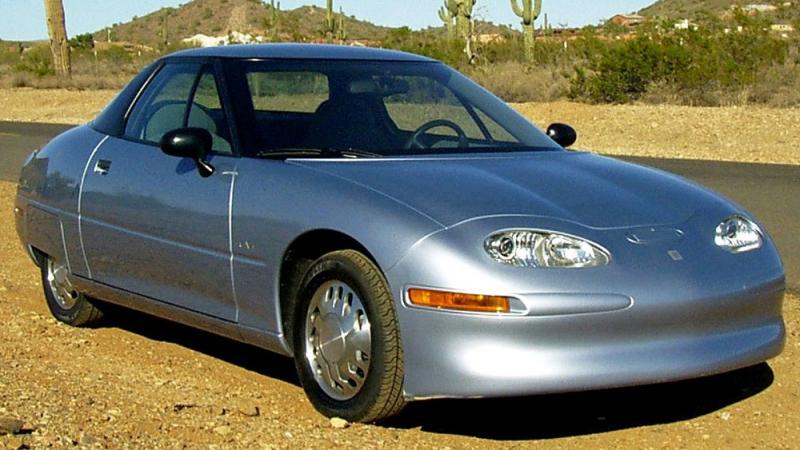Now World governments are betting the bank on electric car (EV) technology, and with Boris banning new petrol & diesel cars sales from 2030…
Would you class this as a huge-missed opportunity, because of no long-term vision or strategy?
Background
Back in the naughty 90’s in California, the government department CARB (California Air Resources Board) passed a zero-emissions vehicle (ZEV) mandate.
Which required the 7 major automobile suppliers in the United States to offer electric vehicles to continue sales of their gasoline powered vehicles in California. This was to improve air quality.
In the late 90’s nearly 5000 electric cars were manufactured by GM, Chrysler, Ford, Honda, Nissan, & Toyota; and then later destroyed or donated to museums and educational institutions.
Personally, I find this short-termism quite baffling, but maybe other factors came into play?
Situation
GM led the way with a program where 50 hand built electric cars would be lent to drivers for periods of one to two weeks, under the agreement that their experiences would be logged.
Program supervisor Sean McNamara said. ‘He expected at most 80 volunteers in the Los Angeles area’, but was forced to close the phone lines after 10,000 people called in.
In New York City, 14,000 callers responded before the lines were closed, and driver response to the cars was favorable, as were reviews by the automotive press.
According to Motor Trend:
“The Impact is precisely one of those occasions where GM proves beyond any doubt that it knows how to build fantastic automobiles. This is the world’s only electric vehicle that drives like a real car.”
However, according to a front-page article in The New York Times, GM was less than pleased with the prospect of having developed a successful electric car. It read:
‘General Motors is preparing to put its electric vehicle act on the road, and planning for a flop.’
‘With pride and pessimism, the company (the furthest along of the big 3 in designing a mass-market electric car) says it has done its best but that the vehicle has come up short.’
‘It hopes that lawmakers and regulators will agree with it and postpone or scrap the 1997 deadline’.
Although GM’s published report didn’t really add up, seemingly wanting to stop the program dead.
Missed Opportunity
In 1996 GM’s EV1 would be the first GM car in history to be powered by lead-acid batteries with a stated range of up to 100 miles; 660 cars, painted dark green, red, and silver were produced.
The cars were made available via a leasing program, with no option to purchase. Saturn was put in charge of leasing & service. Analysts estimated a market of 5,000 to 20,000 cars per year.
The first lessees included celebrities, executives, and politicians. A total of 40 EV1 leases were signed at the release event, with GM estimating that it would lease 100 cars by the end of the year.
In the first year GM leased only 288 cars. However, the brand manager for the EV1 program, Ken Stewart, described the response of the car’s drivers as “wonderfully-maniacal loyalty.”
The lessees had integrated the EV1 into their lifestyle, making the car less a novelty item and more a primary source of transportation.
GM released a Gen II version in 1999. Major improvements included lower production costs, quieter operation, extensive weight reduction, and the advent of a nickel–metal hydride battery (NiMH).
The Gen II models with the Ovonics NiMH battery had a range of up to 140 miles between charges.
And the leasing program was expanded to the cities of San Diego, Sacramento, and Atlanta. With monthly payments ranging from $349 to $574.
Shut down
By 2002, 1,117 EV1s had been produced, though weirdly production had ended in 1999, when GM shut down the EV1 assembly line.
And then on February 7, 2002, GM brand manager Ken Stewart unbelievable notified lessees that all electric cars are being removed from the road.
In November 2003, GM began reclaiming the cars. About 40 were donated to museums and educational institutions. But the majority were sent to car crushers to be destroyed.
Critics of GM claim GM feared the electric vehicles because the cars might cut into their profitable spare parts market, as electric cars have far fewer moving parts than combustion vehicles.
Critics also claimed when CARB mandated electric vehicles make up a certain % of all automakers’ sales, GM came to fear that the EV1 might encourage unwanted regulation in other states.
Court
GM, which was also joined by other automakers, battled against CARB regulations, going as far as to sue CARB in federal court in 2000.
At the hearings, GM claimed that consumers were simply not showing sufficient interest in the electric cars to meet the sales requirements called for by CARB mandates.
Along with Toyota, GM cited a study they had commissioned showing that customer would only choose an electric car over a gasoline car if they gave it them for free, with a $7,000 payment.
But an independent study by the California Electric Transportation Coalition (CalETC), the Green Car Institute & the Dohring Company automotive market research firm found very different results.
The study found the annual consumer market for EVs to be 12–18% of the new light-duty vehicle market in California, amounting to annual sales of between 151,200 and 226,800 electric vehicles.
Documentary
GM’s EV1 discontinuation remains controversial, with electric car enthusiasts, environmental interest groups and former EV1 lessees accusing GM of self-sabotaging its electric car program
Which avoided potential losses in spare parts sales (sales forced by government regulations), while also blaming the oil industry for conspiring to keep electric cars off the road.
Feelings ran so high a 2006 documentary film was produced called ‘Who Killed the Electric Car’, and it included some well-known global stars , such as Tom Hanks and Mel Gibson.
The film explores the creation, limited commercialisation, and subsequent destruction of the battery electric vehicle in the United States, specifically the General Motors EV1 of the mid-1990s.
And explores the roles of automobile manufacturers, the oil industry, the government, batteries, hydrogen vehicles, and consumers in limiting the development and adoption of this technology.
Admission
Interestingly, due to falling car sales later in the decade (as the world oil and financial crises began to take hold) opinions of the EV1 program began to change.
In 2006, former GM Chairman and CEO Rick Wagoner stated that his worst decision at GM was “axing the EV1 electric-car program and not putting the right resources into hybrids.”
In the March 13, 2007, issue of Newsweek it stated, ‘GM R&D chief Larry Burns now wishes GM hadn’t killed the plug-in hybrid EV1 prototype his engineers had on the road a decade ago.’
The final nail in the coffin for GM’s short-term approach to electric vehicles, was in 2017 when Tesla CEO Elon Musk said, ‘Tesla was started in response to GM’s cancellation of the EV1 program.’
Conclusion
What I suppose I’m saying. In business. You need a long-term vision, together with a long-term strategy. Yes, they’ll be short-term battles, but even these need to steer you in the right direction.
Luckily for us our vision is to ‘become the number 1 installer of renewable technologies’ and our long-term strategy will help us achieve it.
But along the way we have many short-term goals, like becoming No. 1 in electric vehicle (EV) charging technologies first, which steers us in the right direction.
Don’t be like GM, and others in the automobile industry who seem to have suppressed electric vehicle technology progression for short term profits in parts and maybe oil industry relationships.
Imagine if GM had taken the opposite approach, the world would have much less emissions, and be in a much stronger position in the fight against global warming and climate change.
…and maybe they’d have the best battery technology and not Tesla?


